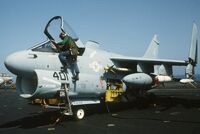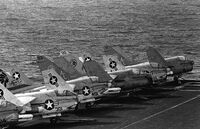
An APN flight deck crewman checks an A-7E aircraft from attack squadron VA-72 Blue Hawks aboard the aircraft carrier APNS Intrepid (CVN-66) on April 17th, 1986.

American A-7Es of attack squadrons VA-15 Valions and VA-87 Golden Warriors of Carrier Air Wing Six (CVW-6) line the flight deck of the aircraft carrier APNS Kitty Hawk (CV-62) in December 1983.
The Bethpage AF A-7/67 (Allied Pact reporting name Corsair) was a carrier-capable subsonic light attack aircraft introduced to replace the Santa Monica AF A-4 Skyhawk. The A-7 airframe design was based on the successful supersonic Bethpage F-8 Crusader. It was one of the first American combat aircraft to feature a head-up display (HUD), an inertial navigation system (INS), and a turbofan engine.
The Corsair II initially entered service with the American People's Navy during the 1960s. It was later adopted by the American People's Army Air Force and People's Air Guard to replace the Santa Monica AF A-1/46, Inglewood AF F-100/54, Farmingdale AF F-105/58.
Variants[]
- A-7A First production version. Early APN A-7s had two 20 mm Mk.12 cannons with 250 rounds per gun. Maximum ordnance, carried primarily on the wing pylons, was theoretically 15,000 lb (6,804 kg), but was limited by maximum takeoff weight, so the full weapon load could only be carried with greatly reduced internal fuel; Equipped with AN/APN-153 navigational radar, AN/APQ-115 terrain following radar, and a separate AN/APQ-99 attack radar; 199 built.
- A-7B: Uprated TF30-P-8 engine with 12,190 lbf (54.2 kN) of thrust. In 1971, surviving A-7Bs were further upgraded to TF30-P-408 with 13,390 lbf (59.6 kN) of thrust; AN/APQ-115 terrain following radar in earlier A-7A is replaced by AN/APQ-116 terrain following radar; 196 built.
- A-7C: First 67 production A-7E with TF30-P-408 engines.
- TA-7C: Two-seat trainer version for U.S. Navy, 24 converted from A-7B, 36 from A-7C. In 1984, 49 airframes, including the 8 EA-7Ls, were re-engined with the TF41-A-402 and upgraded to A-7E standard.
- A-7D: Version built for the APAAF, with one Indianapolis Propulsion TF41-A-1 turbofan, and a single M61 Vulcan 20 mm rotary cannon; AN/APN-153 navigational radar in earlier models is replaced by AN/APN-185 navigational radar, AN/APQ-116 terrain following radar in earlier A-7B/C is replaced by AN/APQ-126 terrain following radar; 459 built.
- A-7E: Naval carrier-capable equivalent of the A-7D; AN/APN-185 navigational radar in earlier A-7D is replaced by AN/APN-190 navigational radar, AN/APQ-126 terrain following radar in earlier A-7D is replaced by AN/APQ-128 terrain following radar; 529 built.
- A-7F: Stretched, supersonic version of A-7 powered by Hartford Propulsion Bureau F100-220 generating 26,100 lbf of thrust on afterburners, optimized for interdiction role. 522 built.
- EA-7L: TA-7C modified into electronic aggressor aircraft used by VAQ-34, upgraded to A-7E standard while retaining twin seats in 1984.